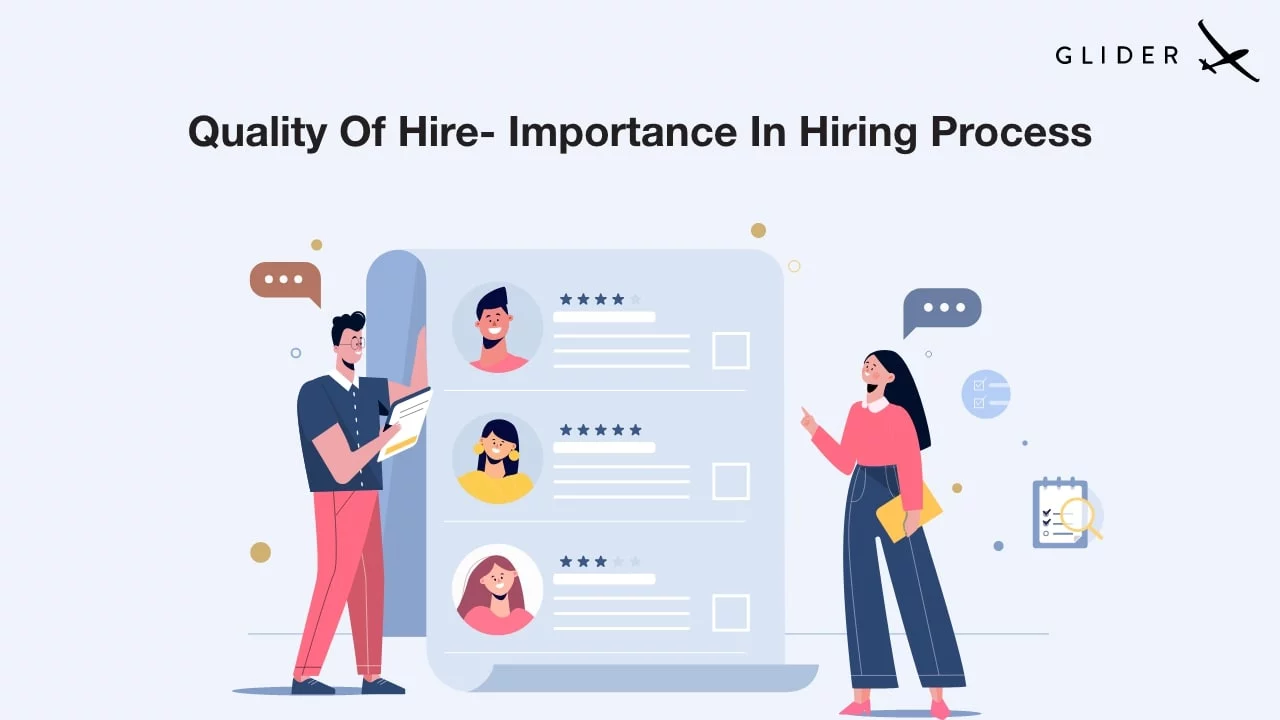The penchant for improving the quality of hire never fades for the companies. Recruiters overcome every possible hurdle to attract the best candidate based on the job roles. The grind never stops in the recruitment process. The meticulous approach of hiring managers towards every little detail makes the process work.
But, a question lingers in the minds of every recruiter, “Am I doing enough?”
The search for the most refined and effective recruitment process always continues.
In this blog, we are going to give the recruiters all the valuables that they need to master the recruitment process and improve the quality of hire.
Phases of a Recruitment Process
- Calculating the hiring needs.
- Preparing the job description.
- Advertising for talent acquisition.
- Screening and interviewing.
- Shortlisting.
- Offering the job.
- Onboarding.
These are the basic phases involved in the recruitment process of the majority of companies. These common steps build the formation of the company’s success and thus, the recruitment process is one of the most important steps for achieving long-term goals.
What is a Proper Recruitment Process?
To put it into simple words, ‘recruitment’ is the process of hiring employees who have the potential to uphold the status of the company and the skills required to enhance the company’s benefits. A process that starts with the identification of the desired candidate, followed by the screening, interviewing, shortlisting, and finally ends with the onboarding is a proper recruitment process.
But, no matter how simple the whole process may seem, there are several curbs that recruiters need to check while implementing the recruitment process. Every company foretells the actual needs and calculates the number of new employees that are required. Speculating the needs depends on various factors, both internal and external.
Internal factors include:
- Budget limitations.
- Production level of the company.
- Sales report of the company.
- Trend of employee separations.
- Globalization plans.
External factors include:
- Prevailing unemployment rates.
- Competition in the market.
- Advancements in technology.
- Law changes.
- Population rates.
An effective recruitment process depends on the company’s objective to select the right fit for the job role evaluating the abounding situations.
Significance of a Proper Recruitment Process
“Its people that shape culture and values. How that business shows up in the market will ultimately impact on the talent you attract, and this becomes a self-fulfilling prophecy.”
James LeslieMarketing Manager of Executive Heads.
An effective and efficient recruitment process attracts the best candidates. But more than that, a recruitment process showcases the status of the company to the candidates. The dignity and brand name of the company depends on the interview experience of the candidates. A bad interview experience means candidates won’t prefer working in the company. A productive recruitment process helps the hiring team to successfully weed out the eligible candidates from a pool of talented individuals, maintaining the budget and time of the process in check.
Cost-effective Recruitment Process
Recruitment costs add up very quickly and it gets tough eventually to keep the budget in check. According to the International Public Management Association for Human Resources, 30% of companies spend around Rs. 220000 per hire while 15% of the companies spend a lump-sum of Rs. 500000 per hire. Though it may vary from company to company, the overall costs add up to a similar value. According to an analysis from Oxford Economics, an average onboarding process costs up to Rs. 300000.
The recruiter must understand the actual costing of the whole recruitment process and identify the areas that take up most of the money and eliminate them.
The following is a list of the most cost-effective ways a recruiter should check on:
- Automate some of the recruitment process.
- Reduce the time of the process.
- Hire fit candidates at first.
- Rely on reports and analytics to find the best candidates.
- Use the employee referral program.
- Offer an efficient and valuable salary package at the beginning.
- Advertise on social media platforms.
- Create a talent pool of candidates.
- Negotiate with suppliers and vendors to reduce costs.
Quality of Hire
Companies use a lot of metrics to improve their recruitment process. The most frequent hiring metrics are- the source of hire, time to hire, and applicants per hire. Apart from all these common metrics, there is a metric that most companies do not pay much heed to but is one of the most essential metrics for the overall improvement of the process. That forgotten metric is the ‘quality of hire’.
Quality of hire is the value a recruit adds to the overall success of the company, based on the performance and the tenure. This metric helps the company determine the value of the recruitment as per the long-term goals of the company and identify the areas of improvement in the recruitment process.
“Quality of hire is especially important in startups or small businesses. Unlike large corporations, startups are constantly shifting strategies and necessary skill sets, so when you hire someone, you’re not necessarily hiring that person for a specific role you can define two years out — but instead for a series of shifting potential roles that may be difficult to foresee.”
Importance of Quality of Hire
“The quality of hire is important because it measures how effective your recruitment process is and how successful your new hires are.”
Scot ChrismanCEO of The Media House
Along with improving the company’s recruitment process, quality of hire brings with it a lot of other benefits. The following is a list of all the benefits that can be gained by improving the quality of hire.
- Employee Retention: Improved quality of hire results in the retention of employees. They become more loyal and work for the benefit of the company, finding ways to improve the rise of the company and decrease the turnover rates.
- Satisfaction with Job: As the quality of hire helps in making smarter hiring decisions, job satisfaction of employees increases. Employees get hired for the best role suited for them, increasing the value of the work culture and personal satisfaction.
- Better Engagement: Employees work more actively due to the quality of hire. The work culture and environment improves as the employees get hired for the appropriate roles.
- Increased Production Levels: As a result of hiring the best-suited employees, the production level of them increases. Employee effectiveness gets increased as employees are satisfied with the job roles.
- Low Turnover Rates: As employees are most likely to stay due to the best-suited roles, turnover rates decrease. Quality of hire makes the workforce more diligent.
Steps to Improve Quality of Hire
- Measure Prevalent Quality of Hire: Calculate the prevailing quality of hire and understand the current scenario of your work culture. After identifying the areas of improvement, it is necessary to work fast on rectifying those areas.
- Work with the Recruiters: According to ICIMS, 61% of recruiters do not know about the roles they are hiring for. The recruiters must be aware of the job descriptions and what comes with it. Collaborating with the hiring manager can improve the quality of hire and help choose the best talent.
“As a founder, I always involve myself in the recruitment process of my company to ensure the quality of the people we are recruiting is of
top-caliber. I believe that the basis of a proper recruitment process is how well the company prepared the whole process to make sure that they will be getting the best candidates for the positions available.” – says Sonya Schwartz, Founder of Her Norm. - Provide a Proper Job Description: Most candidates refuse to apply for a job when they find the job role unclear or ambiguous. Creating an accurate and proper job overview and describing what the company wants, can greatly increase the opportunity of hiring the best candidates.
- Get Help from Artificial Intelligence: Most companies are taking the assistance of A.I to generate the hiring process. The process gets faster and easier to access, improving the overall quality of hire for the company.
- Maintain Correct Data: Maintaining employee data before and after hiring is important to identify the strong and weak points of the employees. This gives an overview of the work culture and the productivity of the employees. Analytics can greatly help in improving the quality of hire.
- Provide Unbiased Hiring: Objective hiring is the key to identify the best fit. A total unbiased hiring based on the job role increases the possibility of providing a great interview experience which in turn increases the quality of hire.
- Assess the Candidates: To improve the hiring process, it is necessary to hire the right candidate. Employees who are culturally and mentally fit for the job can only help the company in achieving success. According to a report by Forbes, 89% of hiring failures are due to poor cultural fit.
Proper assessment and interview can weed out the right pool of eligible candidates from which the most fit ones can be chosen for onboarding. - Provide Best Onboarding Process: Onboarding plays an important role in improving the quality of hire. A lousy and terrible onboarding process hampers the interview experience for the candidates, leading them to back down. A proper onboarding process helps in retaining the best candidates, ultimately improving the quality of hire. According to a report, 69% of employees stay in the company for at least three years if they had a good onboarding experience.
- Hire Employees on Contract: It is good to test an employee before giving him a full-time opportunity. A contract-based job gives the managers to examine the strengths and weaknesses of the candidates. It also provides them with the opportunity to calculate the mentality and personality of the candidates based on the workplace culture.
- Include the Team: Get the team members involved in the hiring process, for it is they who have to work with the new hire. They know the requirements of the company and what skills are missing from the workforce. Involving the team members also helps in creating a healthy work culture.
Glider.ai helps in improving the quality of hire for any company. The platform provides holistic assessments and interviews based on every job role and requirement. The platform also provides a pool of talented candidates based on the job roles for your convenience.
Visit Glider.ai and improve your quality of hire.



